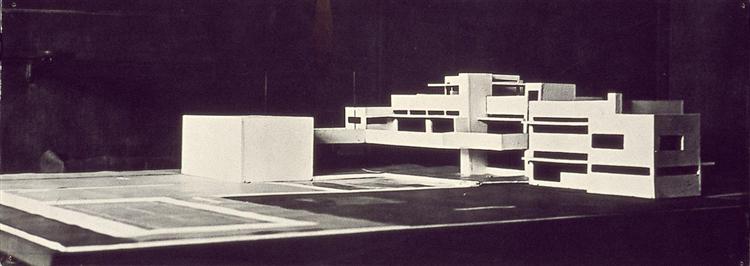Description
The painting "Mansion model" (1923) by Theo Van Doesburg is an outstanding example of the intersection between architecture and visual arts that characterizes the STIJL movement. Van Doesburg, one of the main proponents of this style, together with Piet Mondrian, used this work to explore the relationship between space, shape and color, as well as the possibilities of geometric abstraction in the representation of architectural ideas.
In this work, we observe a composition that challenges the traditional perspective. The representation of the mansion is composed from simple geometric shapes and a deliberate color use. Van Doesburg uses a chromatic scheme composed of primary and secondary tones that emphasize the geometrization of the structure, creating a dynamic dialogue between the different elements. Flat color surfaces are intertwined with straight lines and acute angles, which suggests a sensation of movement and fragmentation, typical of Stijl's aesthetics. This approach not only reflects a tendency towards simplification, but also an aspiration to express a more universal and abstract reality.
One of the most interesting aspects of "mansion model" is its dual function as a work of art and architectural model. Van Doesburg goes beyond the pictorial representation to insinuate an architectural practice, aligning his work with the contemporary exploration of modernist architecture. It is possible that this painting has served as a visual proposal for a possible architectural design, since Van Doesburg was also involved in interior design and architecture in their professional life.
The absence of characters in the work allows the viewer to concentrate their attention exclusively on the structure and design. This approach resonates with the ideal of De Stijl, which promoted the idea that art should be a reflection of the harmony and order of the universe, rather than a mere portrait of everyday reality. Thus, the mansion becomes a symbol of the architectural idealism of its time, representing a search for the essential, the pure and the functional.
"Mansion model" can also be related to other works by Van Doesburg and its contemporaries in the STIJL movement, where the fusion of painting with architecture becomes a field of experimentation. Works by other artists such as Gerrit Rietveld, who shared the same design philosophy, echoes this dialogue between visual art and physical construction, suggesting that the combination of both could lead to new ways of life and social organization.
In conclusion, "Mansion model" not only represents the maturity of Van Doesburg as an artist and his aesthetic firm, but also acts as a bridge between painting, architecture and a new vision of the modern world. Through its use of color and shape, Van Doesburg captures the essence of time and movement that struggled to redefine the norms of art and design, proposing a visual experience that goes beyond the superficial and invites us to Consider the intrinsic relationship between our physical constructions and the surrounding environment. This work, in its abstraction and simplicity, reminds us that art can be both an object of contemplation and a means to imagine a different future.
KUADROS ©, a famous paint on your wall.
Hand-made oil painting reproductions, with the quality of professional artists and the distinctive seal of KUADROS ©.
Art reproduction service with satisfaction guarantee. If you are not completely satisfied with the replica of your painting, we refund your money 100%.

